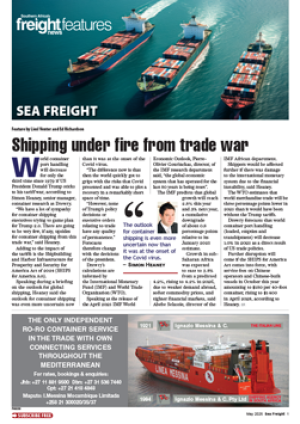ED RICHARDSON
SOUTH AFRICA’S transport infrastructure has had difficulty in coping with the growth in the automotive industry since 1995. As a result ocean carriers like Maersk Line are having to find creative solutions to overcome the limitations, says Chris Swanepoel, national key client manager – automotive of Maersk South Africa But rather than assigning blame for the supply-chain bottlenecks, his mission is to seek solutions. He believes that the best place to start is to get the clients and the major service providers, like SA Port Operations, National Ports Authority, Spoornet, hauliers and the shipping line itself around the same table so that they can better understand each other’s challenges. “It is because of the local port authorities' understanding of the unique needs of the automotive industry that Port Elizabeth is being used in addition to Durban as a port of entry for clients in Gauteng,” says Maersk South Africa’s Eastern Cape branch manager John Reid. “They understand that the auto industry is dynamic and do their best to accommodate us by being as flexible as possible,” he says. For its part, Maersk is offering full logistics and shipping services, with on-line offices in the plants of some of its clients, adds Swanepoel. “We understand that South African original equipment and components manufacturers are competing against low-cost countries around the world. One of the major challenges is reducing the cost of moving cargo around South Africa and the associated risks,” he says. With most factories working on just-in-time or just-in-sequence production systems, there are huge risks associated with delays in delivering components to the plant. Maersk Line manages this risk through named-day services and predictable time slots, he said. Once the cargo has landed, it takes a “well resourced team” that understands the needs of the auto industry to ensure that the containers are cleared and transported to the plant on time, says Swanepoel. The line uses a combination of road and rail to transport goods inland. “Our challenge is to minimise the cost of inland transport, which forms a significant percentage of overall logistics costs,” he says. And he sees encouraging signs that the rail and port authorities are investing in the infrastructure and equipment that are needed to reduce these costs and make the industry more competitive globally – “thanks, in part, to the Maersk Line approach of getting people to sit around the table to discuss their needs,” he added.
Collaboration helps overcome supply-chain bottlenecks
16 Mar 2007 - by Staff reporter
0 Comments
FTW - 16 Mar 07
16 Mar 2007
Eastern companies test-drive new models in SA market ‘If a product sells here, it will sell in the r
16 Mar 2007
16 Mar 2007
16 Mar 2007
16 Mar 2007
16 Mar 2007
16 Mar 2007
16 Mar 2007
Border Beat
Featured Jobs
New
New
